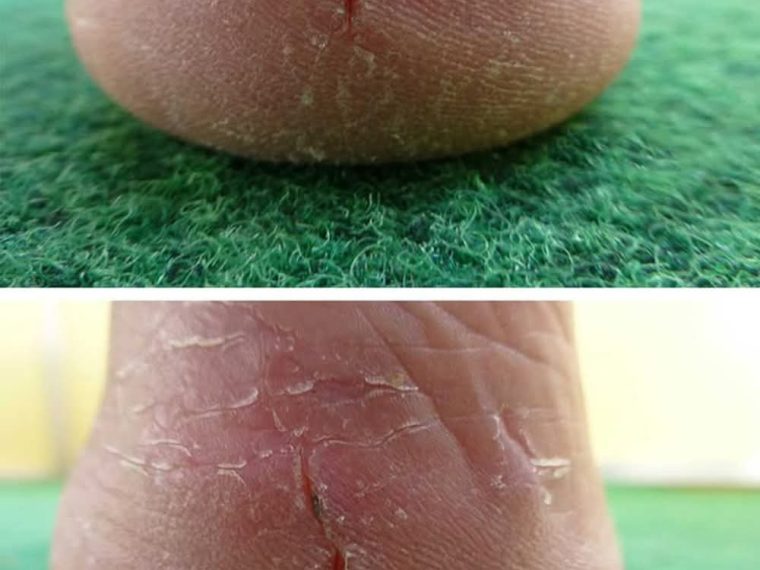Cracked heels, also called heel fissures, are a widespread foot issue that can lead to both physical discomfort and self-consciousness. While mild dryness on the feet is common, severe dryness can cause the skin on the heels to split, resulting in painful cracks. Beyond being a cosmetic concern, untreated heel fissures can lead to infections and more serious complications.
Most people initially reach for lotions or moisturizing creams to soothe cracked heels. However, these treatments don’t always work for everyone. If you’ve been applying lotion regularly without improvement, it may be time to explore other remedies or seek medical advice.

1. What Causes Heel Fissures
Heel fissures develop when the thick skin on the heels becomes extremely dry and loses its elasticity. The constant pressure from standing or walking can cause this dry skin to split even more. Because the skin on the heel is naturally thicker than elsewhere on the body, it’s especially prone to cracking when it becomes dehydrated or hardened.
In more severe cases, these splits can deepen, causing bleeding, pain, and even infection. Addressing the root causes early is essential to prevent further damage and support healing.
2. Common Triggers of Cracked Heels
Several factors contribute to cracked heels:
Prolonged standing on hard floors, which increases pressure on the heels
Open-back shoes or sandals, allowing the heel’s fat pad to expand outward
Excess weight, adding extra strain on the heel
Health conditions like diabetes, eczema, or hypothyroidism that affect skin integrity
Cold or dry weather, which depletes skin moisture
Environmental and lifestyle factors often combine to make the problem worse, especially if proper foot care is neglected.
3. Why Moisturizers Alone Aren’t Enough
While applying lotion can temporarily relieve dryness, it may not fully repair cracked heels. Most lotions only hydrate the surface layer of the skin and fail to penetrate deeper areas affected by thickened calluses or fissures.
If your heels are covered with hard, dry skin, moisture can’t easily absorb. In such cases, you may need additional care—like exfoliation, foot soaks, or using occlusive agents (e.g., petroleum jelly) to lock in moisture overnight.
4. Hydration and Skin Health
Healthy skin starts with hydration—inside and out. When your body is dehydrated, your skin becomes less elastic and more susceptible to cracking. Drinking plenty of water daily helps nourish skin cells from within.
Maintaining proper humidity in your environment is equally important. Using a humidifier during dry or winter months can help prevent your skin—and especially your feet—from drying out.
5. Exfoliation: An Essential Step for Heel Care
Exfoliating the feet is a crucial part of treating cracked heels because it helps remove layers of dead skin, reducing thickness and allowing moisturizers to absorb more effectively. You can use a pumice stone or foot file after soaking your feet to soften the skin.
Doing this once or twice a week can help prevent the build-up of hard, callused skin that often leads to cracking. However, be gentle—scrubbing too hard can irritate or damage the skin and make the problem worse.
6. The Benefits of Foot Soaks
Foot soaks are a simple yet soothing way to care for cracked heels. Soaking your feet in warm water for 10–15 minutes helps soften rough skin, making exfoliation and moisturizing easier. Adding Epsom salts can relieve inflammation and soreness, while apple cider vinegar—thanks to its mild acidity—can help break down thick skin.
After soaking, dry your feet completely and apply a rich, hydrating cream or oil to lock in moisture and keep the skin soft.
7. Choosing Proper Footwear
Wearing the right shoes is vital for both preventing and treating cracked heels. Footwear that offers good support and cushioning helps distribute weight evenly and reduces pressure on the heel area. Avoid open-backed shoes or flip-flops, which can cause the heel pad to expand and crack.
If you’re on your feet for long hours, choose shoes with arch support and shock absorption to protect your feet. Also, wearing breathable socks helps control moisture and prevents irritation.
8. How Diet Affects Skin Health
A nutritious diet plays an important role in maintaining smooth, healthy skin. Vitamins and minerals such as vitamin E, vitamin C, zinc, and omega-3 fatty acids help with skin repair and regeneration.
Include foods like nuts, seeds, oily fish, fruits, and leafy greens to get these essential nutrients. Keeping your weight in check also helps reduce excess pressure on your heels, minimizing the chance of cracks.
9. Popular Home Remedies
Some natural remedies have become well-known for treating cracked heels. For instance, a mix of honey and coconut oil can deeply moisturize and protect against bacteria. Another simple remedy is a banana mask, as bananas are packed with skin-softening vitamins.
While these methods may offer short-term relief, they don’t work for everyone. If your heels remain painful or severely cracked, it’s best to consult a healthcare provider.
10. When to Seek Professional Care
If heel fissures become deep, painful, or infected, it’s important to see a podiatrist or dermatologist. They can recommend treatments such as prescription-strength creams, antibiotics, or minor procedures to remove thickened skin.
For people with conditions like diabetes, professional care is especially critical, as untreated heel cracks can lead to serious complications.
11. Preventing Cracked Heels
Healthy heels come from consistent care. Keep your feet moisturized, wear supportive shoes, and stay hydrated. Pair these habits with a nutrient-rich diet and regular exfoliation to maintain soft, supple skin and prevent future cracking.
It’s also important to pay attention to any changes in your skin condition and address them early on to prevent the development of painful heel fissures. By taking proactive steps, you can enjoy healthy, crack-free heels year-round.





